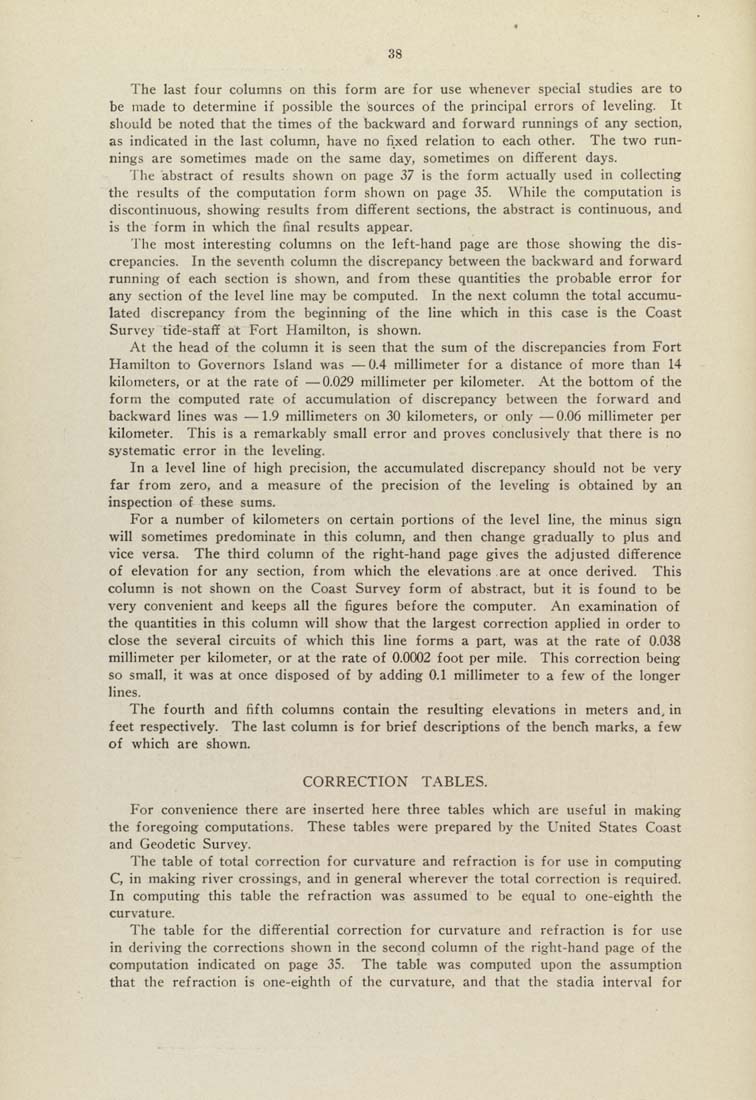The last four columns on this form are for use whenever special studies are to
be made to determine if possible the sources of the principal errors of leveling. It
should be noted that the times of the backward and forward runnings of any section,
as indicated in the last column, have no fi,xed relation to each other. The two run¬
nings are sometimes made on the same day, sometimes on different days.
The abstract of results shown on page Zl is the form actually used in collecting
the results of the computation form shown on page 35. While the computation is
discontinuous, showing results from different sections, the abstract is continuous, and
is the form in which the final results appear,
Tlie most interesting columns on the left-hand page are those showing the dis¬
crepancies. In the seventh column the discrepancy between the backward and forward
running of each section is shown, and from these quantities the probable error for
any section of the level line may be computed. In the next column the total accumu¬
lated discrepancy from the beginning of the line which in this case is the Coast
Survey tide-staff at Fort Hamilton, is shown.
At the head of the column it is seen that the sum of the discrepancies from Fort
Hamilton to Governors Island was — 0.4 millimeter for a distance of more than 14
kilometers, or at the rate of —0.029 millimeter per kilometer. At the bottom of the
form the computed rate of accumulation of discrepancy between the forward and
backward lines was —1,9 milhmeters on 30 kilometers, or only —0,06 millimeter per
kilometer. This is a remarkably small error and proves conclusively that there is no
systematic error in the leveling.
In a level line of high precision, the accumulated discrepancy should not be very
far from zero, and a measure of the precision of the leveling is obtained by an
inspection of these sums.
For a number of kilometers on certain portions of the level line, the minus sign
will sometimes predominate in this column, and then change gradually to plus and
vice versa. The third column of the right-hand page gives the adjusted difference
of elevation for any section, from which the elevations are at once derived. This
column is not shown on the Coast Survey form of abstract, but it is found to be
very convenient and keeps all the figures before the computer. An examination of
the quantities in this column will show that the largest correction applied in order to
close the several circuits of which this line forms a part, was at the rate of 0.038
millimeter per kilometer, or at the rate of 0.0002 foot per mile. This correction being
so small, it was at once disposed of by adding 0.1 millimeter to a few of the longer
lines.
The fourth and fifth columns contain the resulting elevations in meters and, in
feet respectively. The last column is for brief descriptions of the bench marks, a few
of which are shown.
CORRECTION TABLES.
For convenience there are inserted here three tables which are useful in making
the foregoing computations. These tables were prepared by the United States Coast
and Geodetic Survey.
The table of total correction for curvature and refraction is for use in computing
C, in making river crossings, and in general wherever the total correction is required.
In computing this table the refraction was assumed to be equal to one-eighth the
curvature.
The table for the differential correction for curvature and refraction is for use
in deriving the corrections shown in the second column of the right-hand page of the
computation indicated on page 35. The table was computed upon the assumption
that the refraction is one-eighth of the curvature, and that the stadia interval for
|








